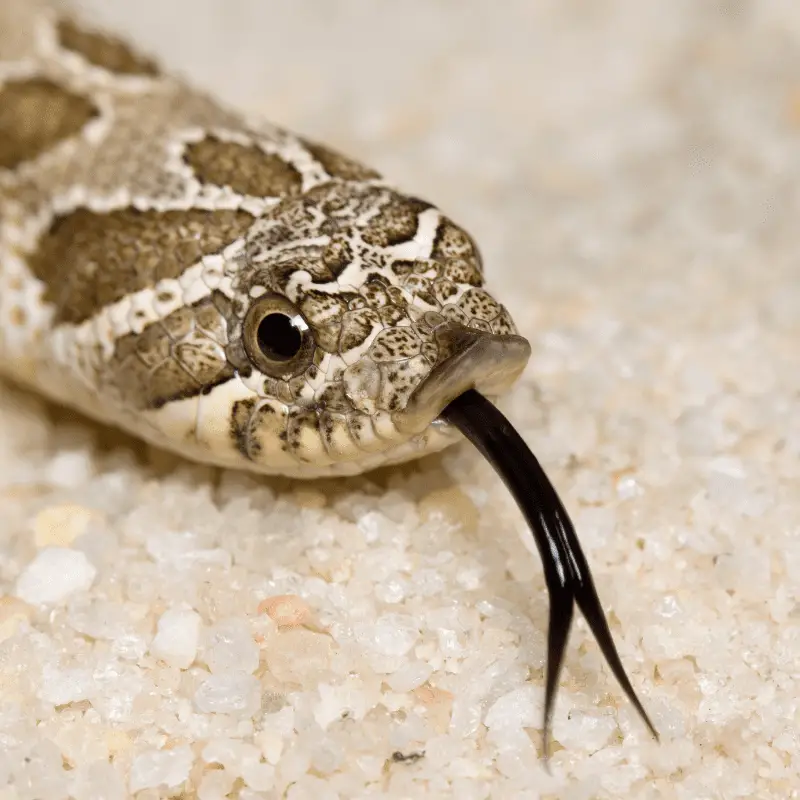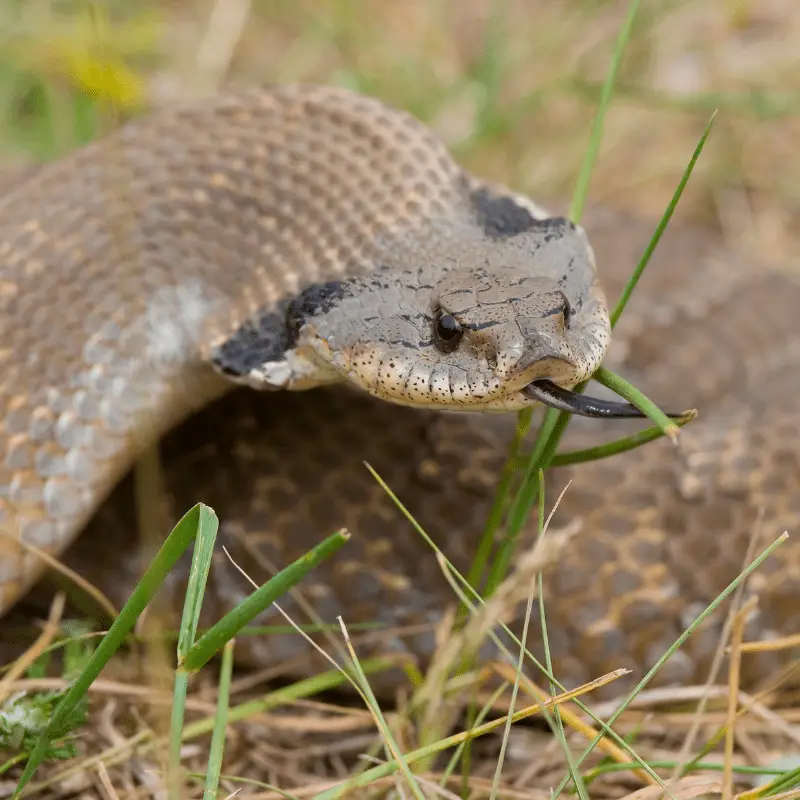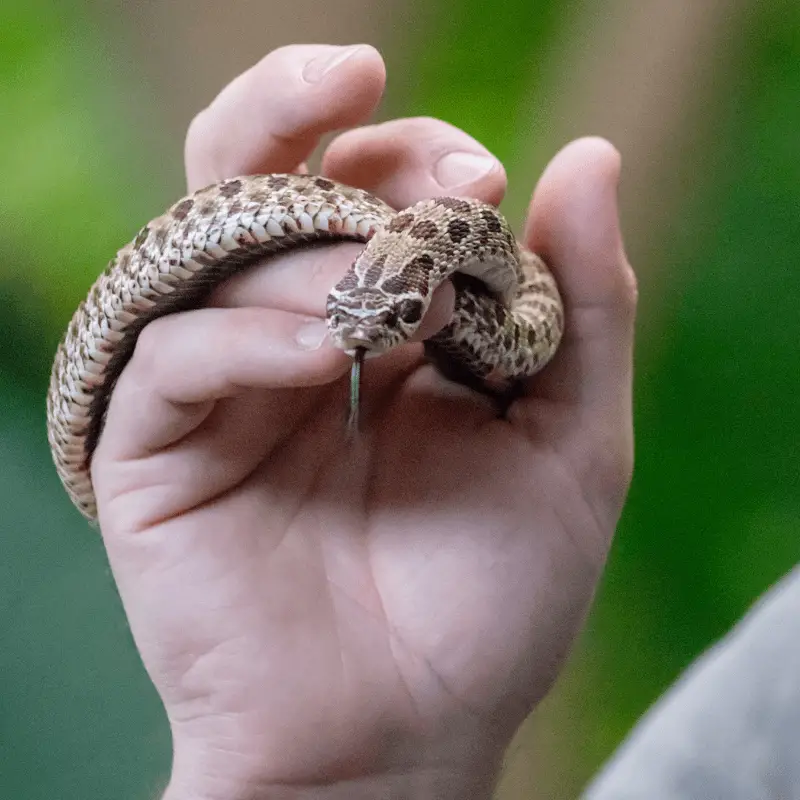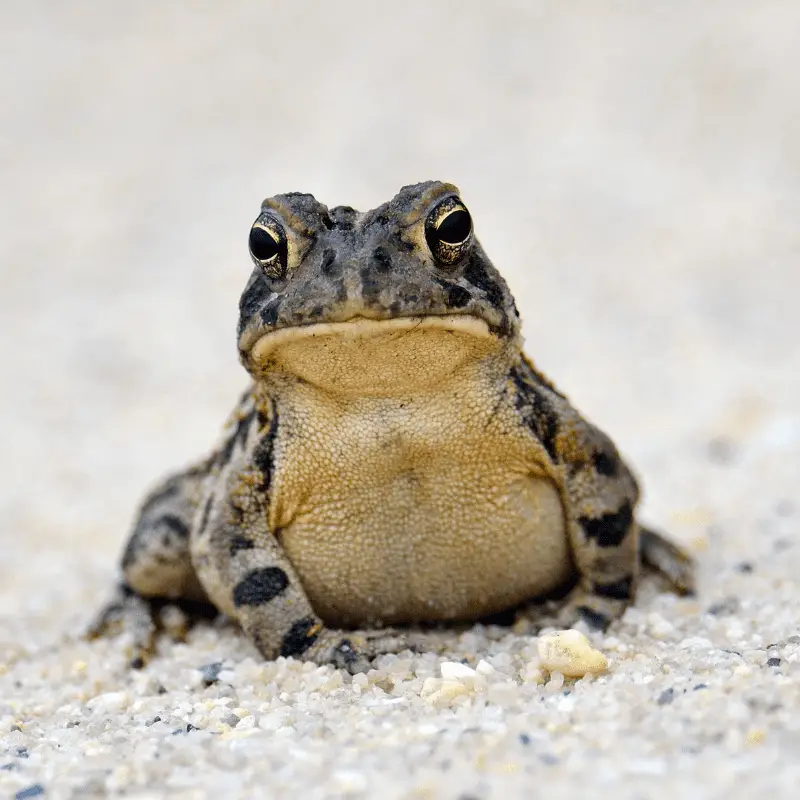The term hognose snake does not indicate a single type of snake. It instead denotes the number of snake species with distinct upturned snouts similar to the hogs’ snouts. These mildly venomous snakes use their upturned snouts for digging.
These snakes come from three distinct genera; the Leioheterodon, Heterodon, and Lystrophis.
Origin
These snakes are common in South America, North America, and Madagascar.
The Hognose snakes have round eyes and thick round bodies. These snakes are pretty small in size, which made them one of the most popular pet snakes. These snakes have a timid nature. They get easily startled and often prefer to hide from the predators rather than attacking them.
When threatened, these snakes flatten their neck and head and feigns to strike with a loud hiss. However, they rarely bite the attacker. If this bluff fails, they often roll over to feign death. Even in captivity, they tend to show similar nature and rarely turn aggressive.
If you want a pet snake in your home, then hognose snakes can be one of the best choices. Once you understand their housing and feeding routines properly, maintaining the hognose snakes is pretty easy.

Overview of the Species
- Common Name: Hognose Snake
- Scientific Name: Leioheterodon, Heterodon, and Lystrophis
- Family: Colubridae
- Adult size: The size of the snakes is less than 2 feet on average. However, some snakes can grow up to 4 feet in length.
- Life Expectancy: 8-10 years
Geographic Range
Heterodon platirhinos or eastern hognose snakes are a natural habitat of the near arctic region of North America. The range of the snakes extends along the eastern coast of the USA. However, you can see these snakes quite often in the central region of the country as well.
These snakes are found in about 30 states of the United States and the southern section of Ontario. In the east coast region, the snakes can be found from Southern New Hampshire to the Southern end of Florida. The population of the central USA is spread from Southern Texas to Minnesota.
Habitat
The Hognose snakes of Eastern parts of the USA are mostly found on the sandy, dry or mixed soil. You can often spot these snakes on the grassy fields or the fields full of crops. These snakes also love to live on the edges of the woodlands.
However, they have a preferred woodland type. Most of the hognose snakes are found in the hardwood or thinly wooded pine-filled areas. Even though these snakes love the well-drained areas, sometimes you can spot them near small water bodies as well. The Savannah Riverside is one of the places where you can still find the hognoses quite often.
Apart from nature, the hognose snakes are sometimes found in the greenhouses and barns. But, these places are not the typical habitats of these snakes.
Physical Description
The thick bodies and the wide heads of the snakes are their primary features of these snakes. However, the slightly upturned snout is one of the identifying features of the snakes. The length of the adult male snakes ranges between 45-105 cm. The female snakes are larger than their male counterparts.
The juvenile snakes often showcase a pink colouration along with black and brown blotches in alternating order. The rows continue to the end of their bodies. However, once these snakes become adults, these colours get changed, turning these snakes one of the most colourful ones. The colour of the snakes varies from light grey, tan, red, yellowish, and greyish tan. Some of the snakes showcase even solid grey or even black colour. The blotches one can find on the snakes are more prominent on the dorsal sides and smaller on the lateral sides of the body. The ventral sides of the snakes can be white to light grey. However, the colouration is still lighter than the dorsal side.
Along with that, the underside section of the snakes’ tail comes with lighter colouration than the ventral part. The Eastern Hognoses generally come with twenty-three to twenty-five rows of dorsal scales and the divided anal plate.

The male hognose species comes with a hundred and twenty-six ventral scales, whereas the females come with 138 ventral scales. The male and the female snakes differ in the number of subcaudal scales as well. The males come with 51 subcaudal scales, whereas the females have only 39 subcaudal scales.
Southern hognose scales can be easily distinguished from their eastern partners. Unlike their eastern counterparts, the southern hognose snakes generally come in tan, grey, or reddish colour with dark brown blotches on the centre of their backs. These blotches never turn solid black like the eastern hognoses.
One can differentiate these two snakes just by checking out their tails. The underside of the tail of the southern hognoses is of the same colour as their belly. For the eastern snakes, the colour pattern of the underside of the tail is a bit lighter.
The snouts of the southern hognoses are more prominent than the Eastern ones. Even though the threat display of the southern hognoses is less common compared to the eastern variation, they do demonstrate it.
Reproduction
The Eastern hognose snakes exhibit polyandrous characteristics. That means these hognoses have multiple mates in a single mating season. During the mating season, the males follow the scent trails of the female snakes in a similar way they pursue their prey.
The hognoses mate once every year, in the spring and early summer. In the winter season, the hognoses are rarely seen above ground. Once the cold recedes, the hognoses come out of their underground burrows and start the mating rituals. If these snakes do have a second breeding phase in September and October, the female tends to store the sperm till the following spring.
The male snakes tend to travel a further distance to find their mates than the females. Most female hognoses prefer to stay in the best egg-laying places where they can ensure maximum hatching success of their eggs. The nests that the females create are generally located in the areas that get the highest exposure to sunlight.
Once the males and females find each other, the copulation process starts. This process can last up to three days. During this time, the males keep on alternating between their hemipenes. The gestation period for the female hognoses is about 40-50 days long. The females generally lay 10-30 eggs between early June to late July.
Most of the time, the females lay their eggs beneath rocks and bury them under the sandy soil. The eggs hatch during August and September. The hatchlings are generally 10-20 centimetres in length. In their growth period, the hatchlings can grow as long as two centimetres per month.

Sometimes, the female hognoses incubate their eggs. During this phase, they bury themselves with their eggs and coil around the eggs. The incubation period is generally dependent on the temperature of the nest. The higher the ambient temperature of the nest. The higher temperature of the nest shortens the incubation period significantly.
Behaviour
The hognose snakes are generally diurnal animals. They become the most active during the mid-day. Even though these snakes are not found near water bodies, they can swim to reach their food or potential mates. In the summer months, these snakes are most active. Their hibernation phase starts from the early part of September till November, and it continues till the early spring.
These snakes go on hibernation in either self-made burrows or the ones left by the mammals. These snakes can go as deep a 25 centimetres when they are sleeping or during the hibernation period.
Home Range
Most of the time, the hognose snakes choose the low slope areas as their home range. The home range often spreads about fifty hectares of land. The home range of the male snakes is usually larger than the females as they tend to travel more distance. The females generally have a smaller home range as they prefer to stay near the places ideal for the egg developments. However, the hognoses do not tend to defend their territory within the home range.
Perception and Communication
The hognose snakes generally depend on the olfactory cues to form an idea about their environment. Their eyesight is not great. They often suffer extreme difficulty finding their prey using only their eyesight. They use their tongue to pick the chemical cues and then transfer them to the olfactory organ in their Jacob’s organ located on the roof of their mouths. While following the females, the males similarly trace the pheromone trail.
Food Habit
Hognose snakes are known to have frogs, small mammals, small reptiles, salamanders, and fishes as their prey. But mostly, they eat toads. Some of the snakes even have insects and worms. The toads they prefer are known to secrete a special toxin that can be fatal to any animals that try to eat them. However, the digestive enzymes of the hognose snakes are strong enough to neutralize the toxins of the toads.

The toads also inflate their bodies as a defence mechanism, but the hognoses have enlarged teeth, which they use to deflate the toads while eating them. The upturned snouts of the snakes help them to dig the ground to find out the burrowing toads. The snakes also use their mild venom to subdue their prey before swallowing them. The juvenile snakes, on the other hand, depend on crickets or other such insects and worms.
- Small mammals
- Small reptiles
- Salamanders
- Fish
- Toads
Predation
Animals, like foxes, raccoons, Virginia opossums, and other predatory birds, tend to feed on the hognoses. Some of the more giant snakes, like cottonmouths and king snakes, also prey on hognoses.
During predation, the hognoses often pretend to be dead to avoid predators. This apparent death or thanatosis is one of the defence mechanisms that animals of different species often use.
Many hunters prefer living prey and leave the dead ones for the scavengers. The hognoses take advantage of this nature of the predators and play dead when threatened. They keep their mouth open and let their tongue roll out their mouth. These snakes even perform convulsion while feigning death. If these snakes are righted after they have feigned their death, they will keep on flipping back and continuing the defensive behaviour.
The snakes do not just perform a painful death scene, but they also secrete a foul-smelling liquid to make their death scene more convincing and themselves even more unpalatable. The surprising thing is that even the newborn ones perform the same defensive behaviour as the adult ones.
The Eastern hognoses do not try this melodrama whenever they feel threatened. Before faking their deaths, these snakes often flatten their necks and head much like the cobras and hisses loudly. Even though they pretend to attack, most of the time, hognose do not bite their attackers. However, that does not mean they do not have any toxins. Contrary to popular belief, hognoses are venomous snakes. However, they have mild venom, which is not that dangerous to humans.
Economic Importance
The hognoses eat small mammals, amphibians, and insects. That means they play a significant role in limiting the populations of these animals. They play the most vital role in limiting the population of the toads.
Even though these snakes are mildly venomous, their bites can result in bruising, swelling, and pain around the bite area.
Captive Hognoses
It can be challenging to feed the hognose snakes in captivity; staying consistent with what and when you feed the snakes can make a huge difference. Also, always keep the temperature of the hognoses in mind. These snakes need warmth and activity to digest their food properly. Other than that, keep an eye out for the different diseases, like respiratory infections and mouth rot.
Conservation Status
The hognose snakes are listed as the species on the ‘least concerned’ list of IUCN red list. These snakes do not have any special status on any of the Federal Government’s conservation lists. However, due to the destruction of habitats, the future of the snakes may be of concern. These snakes are often mistaken as pygmy rattlesnakes and killed. If not controlled, this can lead the snake into decline.

